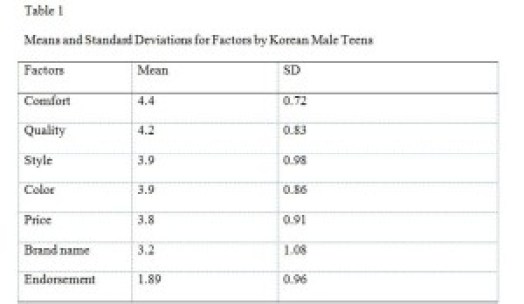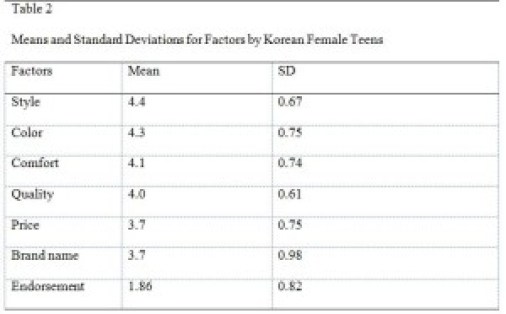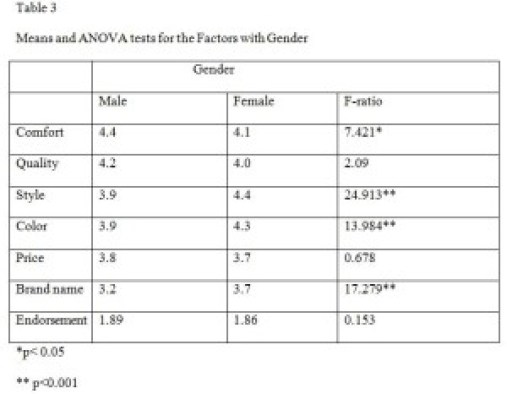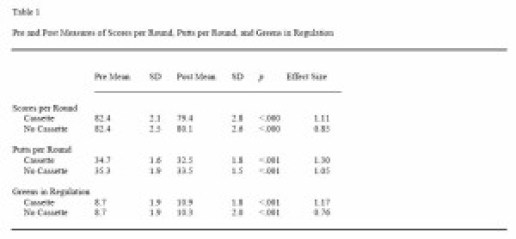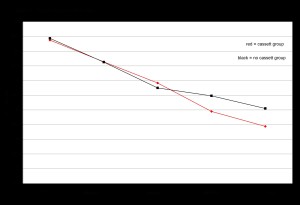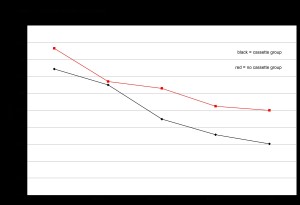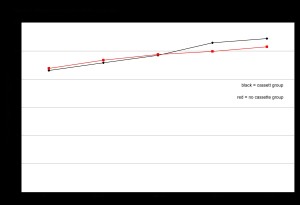The Effect of Gender on Korean Teens’ Athletic Footwear Purchasing
Submitted by Dr. Taeho Yon*1, Mr. Brian Gordon*2, and Mr. Mike Mohr*3.
*1 Southern Illinois University, Carbondale, IL 62901, USA
*2 Southern Illinois University, Carbondale, IL 62901, USA
*3 Southern Illinois University, Carbondale, IL 62901, USA
Dr. Taeho Yon is an assistant professor in the Department of Physical Education at Southern Illinois University. He received a bachelor’s degree from Hongik University in South Korea, a master’s degree in recreation and sport management from Indiana State University and a Ph.D. in Sport Management from Florida State University.
Brian Gordon is a graduate student in sport management at Southern Illinois University. His area of interest includes legal aspects, sport marketing, and administration of intercollegiate athletics.
Mike Mohr is a graduate student in sport management at Southern Illinois University. His area of interest includes sport marketing (consumer behavior) and issues of people with disabilities in sport.
Abstract
The purpose of this study was to investigate factors that influence Korean teens’ athletic footwear purchase. Four hundred and fifty-six teens participated in the study. Throughout the review of related literature and the conduction of a pilot study, seven characteristics were considered; price, color, style, brand name, comfort, quality, and celebrity endorsement. ANOVA procedures indicated that gender played a significant role in the purchasing behavior of Korean teens. Male teens stated that comfort and quality are the most important factors while female teens revealed that style and color are more important factors than any other factor. Marketers and advertising managers of athletic shoes companies should utilize the findings of this study to communicate with teen consumers more effectively.
Key Words: Korean teens, Consumer behavior, Athletic Footwear,
In recent years, the buying power of the teenage Korean market has significantly increased. According to Park (2002), in 2003, there were approximately 11.3 million (23.9% of total population) teens in Korea, with an estimated 10 billion dollars in buying power. The Korean Institute for Youth Development projected that teen spending will significantly increase over the next ten years. Lee (2003) also pointed that due to the one child policy, which limits parents to having only one child to curb overpopulation, teens in Korea assume a greater role as consumers in the household and justify where funds are allocated. According to a report by Korea Institute for Youth Development (2004), Korean teens exert an influence on more than $36 billion in family purchases. The report also stated that most Korean teens make purchases with money that is provided by their family. Further, they ask their parents to buy a variety of products that are not teen products such as food, furniture, electronics, and other household products. New trends have developed within the Korean teen subculture. As a result, consumer behavior will change (Kim, 2002; Lee, 2003; Lim 2001). Lee (2003) stated that unlike previous generations, today’s Korean teens have different consumption behavior. They are very concerned about the conspicuousness of the products. In other words, they are very conscious about how they look from others viewpoints or the image they reflect upon others. As a result, they will place a higher value on aesthetics over quality. Woo (2001) also stated that approximately 50% of teens expressed design as the most important factor when they purchase teen-related products. Design and styles are viewed as more relevant characteristics among female teens in Korea. Consequently, parents consider secondary factors such as design and style over quality and comfort. Today’s teens are easily influenced by various advertising which presents role models such as sport entertainers (Lee, 2003). Lee (2003) found that 80% of teens are somewhat influenced by advertisements and believe the products advertised by celebrities have better conspicuousness than products that were not endorsed by celebrities. Korean teens are very sensitive to current fashion trends and have impulsive purchasing behavior (Kwon, 2000; Lim, 2002). Lim (2002) found that almost 50% of Korean teens have purchased products impulsively. They place a greater emphasis on the style and color of a product over the quality aspect (Kim 2000). Korean teens identify with certain brand products that help express their identity and characteristics. This consumer behavior is the most important factor that leads to a purchase (Lee, 2003; Lim 2002). Lee (2003) found that 79% of Korean teens care about product brands and have a strong brand loyalty to a certain brand of athletic shoes. Wearing a certain brand of footwear is very important for a teenager because it is a way of fitting in and gaining acceptance by the peer group (Forney & Forney, 1995; Miller, 1994). Among the teen products, athletic shoes are one of the highest brand loyalty items among Korean teens (Lee, 2003).
Apart from this, the teenage period is the life stage in which an individual’s consumption leverage increases dramatically in terms of financial resources and decision-making discretion (Shim & Gehrt, 1996). Hence, with the strong marketing impact that teens create, marketers and consumer researchers become increasingly interested in exploring the shopping behavior of teens (Kamaruddin & Mokhlis, 2003). Often such teen shopping behaviors are influenced by their demographic background. Among the different demographic variables, gender has been considered as one of the most influential variables due to the following reasons: (1) gender is easily identifiable, (2) gender segments are accessible (since most media provide this information), and (3) gender segments are large enough to be profitable, gender is still a frequently used variable to implement segmentation strategies. (Stevens, Lathrop, & Bradish, 2005; Belk, 2003; Cleveland, Babin, Laroche, Ward, Bergeron, 2003; Darley & Smith, 1995; Meyers-Levy & Sternthal, 1991). In the sport product segment, some research investigated gender differences on athletic shoes purchasing (Belk, 2003; Lyons & Jackson, 2001). However, previous research showed inconsistent results. Belk’s (2003) study found a gender difference on athletic shoes purchasing, but Lyons & Jackson (2001) found that African-American teens did not show gender differences on athletic shoe selection. Moreover, although there is the practical importance of gender differences in the field of consumer behavior and a growing interest in the consumer behavior of teens in Korea, a meager amount of research has been conducted to investigate the gender differences on the factors that influence teens purchasing athletic shoes in Korea.
The primary purpose of this study is to investigate the factors that influence Korean teens purchasing athletics shoes with association of gender.
Method:
Participants
Participants for this study were five hundred twenty-five randomly selected teens from 6 schools in a metropolitan area of Korea. Self-administered surveys were given to participants. Of the 525 returned survey questionnaires, 456 were usable. Female teens represented 46% (211) and 54% (245) were represented by male teens.
Instrumentation
A survey was developed through literature reviews and discussions with teenagers in Korea. A pretest was conducted for 37 Korean teens and the survey questions were revised to make them more appropriate for the population tested in this study. The survey consisted of two parts with 18 questions. The first part included demographics of gender and age. The second part of the survey consisted of questions about the factors that influence Korean teens to purchase athletic shoes. From the review of relevant literature, seven most important factors were identified: style, price, brand name (recognition), color, quality, comfort, and celebrity endorsement. For this section, a five-point Likert-type scale (5-Strongly agree 1-strongly disagree) was used to rate the agreement of each factor. The following is a sample statement for each information source:
• Style: When I purchase athletic shoes the style of shoes is very important
• Comfort: When it comes to deciding to buy athletic shoes, comfort is the most important factor.
• Quality: I often purchase athletic shoes which are very durable
• Price: I’m very concerned about the price of shoes
• Brand name: I am very concerned about the brand name of shoes
• Color: When purchase athletic shoes, color of the shoes is one of the major concerns
• Celebrity endorsement: I often purchase same athletic shoes that a celebrity whom I admire wore.
The data collection process was completed in five weeks. Data were entered and statistics calculated by SPSS 12.0 for Windows program. Descriptive statistics of mean and standard deviation were acquired to analyze the data. Analysis of Variance procedures were conducted with factor scores, with independent variable of gender. Alpha values were set at 0.05 to determine significant differences between genders.
Results
Descriptive statistics generated from the questionnaire indicated that for male teens comfort of shoes (M = 4.4, SD = 0.72) is the most important factor. The second most important factor is quality (M = 4.2, SD = 0.83). (See Table 1).
For female teens style (M = 4.4, SD = 0.67) and color (M=4.3, SD=0.75) are two most important factors. (See Table 2).
ANOVA for gender are represented in Table 3.
ANOVA found that there is a significant difference between genders on style (F=24.913, p = 0.001). Style is the most important factor for female teens (M=4.4) while the third most important factor for male teens (M=3.9). There is a gender difference on the importance of comfort (F=7.421, p= .007). Comfort is more important factor for male teens (M=4.4) than for females (M=4.1).The importance of brand name differs between genders (F=17.279, p= .001). Brand name of the shoes is more important factor for female teens (M=3.7) than for males (M=3.2). The data revealed that there is no significant difference between genders on quality, price, and endorsement of athletic shoes.
Discussion and Managerial Implications
The results of this study provide empirical evidence regarding factors that influence Korean teens purchasing athletic footwear in relation to demographics.
The influence of factors differs between genders. This study found that for male teens, the comfort and quality are the two most important factors while female teens ranked the style and color as the most important factors. There were significant differences between genders on style, comfort, and brand name. Interestingly, female teens showed higher scores for some physical factors of the products, style and brand name, than male teens while male teens consider internal factors such as comfort as a more important consideration. This finding is consistent with a previous study (Park 2002; Solomon & Schopler, 1982; Taylor & Cosenza, 2002). Females are more sensible about the appearance of the product such as style, design, and brand name while males tend to consider internal factors such as comfort and quality as more important factors. Belk (2003) also found a gender difference on perception toward athletic shoes, with women being more alert to the symbolic implications of shoes than men. Women strongly feel that their footwear is an expansion and expression of themselves. They also feel that shoes affect their perceptions of others and their perceptions of self. Compared to male consumers, female consumers see shoes as highly significant articles of clothing that are regarded as expressing the wearer’s personality. Furthermore, for adolescents especially females, shoes are a key signifier of their identity (Belk, 2003; Park, 2002). Male consumers, on the other hand, see shoes as a utilitarian thing. As a consequence, the style that they identify with most is the critical purchase decision-making factor for Korean female teens while comfort is the most important consideration for male teens in Korea. Some researchers applied socio-cultural perspective to explain the fact that physical appearance is greater for women than for men (Burton & Netemeyer, 1995; Jackson 1992; Kim, 2002; Lee 2003; Striegel-Moore, Silberstein, & Rodin, 1986). In Korea, women are generally viewed as having less social power than men (Kim, 2002; Lee, 2003).Lee (2003) stated that in Korea, traditional perceptions of the male role have centered on the man as the worker and financial provider, whereas the traditional female role has been outside of the workforce such as raising children. As a consequence, often the physical attractiveness is used as a more important evaluative cue for women because of the less “objective” criteria available for judging their successful role fulfillment. This perspective is supported from other research (Burton & Netemeyer, 1995; Jackson 1992; Buss & Barnes 1986). Buss and Barnes (1986) revealed that women select their spouse on the basis of their social power (as a means of elevating social position), whereas men, as the sex with greater social power, choose their spouse more on the basis of beauty and physical attractiveness. This perspective implies that women use their appearance as a means to enhance social power (Burton & Netemeyer, 1995). Thus, the women’s concern about their physical appearance is far greater than that of men. Such a perception and orientation certainly impacts on their purchasing behavior (Brownmiller 1984).
This study provides critical information to marketers and advertising directors of athletic shoe companies which target Korean teens. This study found that Korean male and female students are affected by different factors when they purchased athletic shoes. Male teens seek comfortable and quality shoes while female teens consider the appearance of the product, such as style, color and brand names, as the more important factor. Therefore, marketers and advertising directors should pay emphasis on the comfort and quality for male athletic shoes advertising. For female teens, they should create more the eye-appealing advertisements. The finding of this study should be interpreted in light of some limitations. First, although the sample size was not small, the samples were drawn from schools in a metropolitan area. Therefore, it is recommended for future studies to have samples from a wider geographical distribution to provide more generalized findings. Second, demographic characteristics other than gender should be considered in future studies. For example, future studies on this topic should examine demographic characteristics such as age, education, race, and socio-economic status. Different demographic characteristics may have a significant impact on consumption behavior.
References
Belk, R.W. (2003). Shoes and Self. Advances in Consumer Research, 30 (1), 27-34.
Brownmiller, S. (1984). Femininity. New York: Simon and Schuster.
Buss, D. M., & Barnes, M. (1986). Preferences in human mate selection. Journal of Personality and Social Psychology, 56, 735-747.
Burton, S., Netemeyer, R. G. (1995). Gender differences for appearance-related attitudes and behaviors: Implications for consumer. Journal of Public Policy & Marketing, 14 (1) 60-76.
Cleveland, M., Babin, B. J., Laroche, M., Ward, P., & Bergeron, J. (2003). Information search patterns for gift purchases: A cross-national examination of gender differences. Journal of Consumer Behavior 3 (1), 20-47.
Darley, W. K., & Smith, R. E. (1995). Gender differences in information processing strategies: An empirical test of the selectivity in advertising response. Journal of Advertising, 24 (1) 41-56.
Forney, J., & Forney, W. (1995). Gangs or fashion: influences on junior high student dress, Journal of Family and Consumer Sciences, Vol. 87, pp.26–32.
Jackson, L. A. (1992). Physical Appearance and Gender: Sociobiological and Sociocultural Perspectives. Albany, NY: State University of New York Press
Kamaruddin, R. A., & Mokhlis. S. (2003). Consumer socialization, social structual factors and decision-making styles: a case study of adolescents in Malaysia. International Journal of Consumer Studies, 27(2),145-157.
Kim , B. J. (2000). A Research on Consumption Behavior Among Youths. Unpublished Masters Thesis, Changwon University, Korea.
Kim, S. S. (2002). Korean Adolescents’ Purchasing Behavior for Hip Hop Clothes. Unpublished Masters Thesis, Yonsei University, Korea.
Korea Institute for Youth Development. (2004). Spending Power of Korean teens. Retrieved August 2, 2005 from http://www.youthnet.re.kr/
Kwon, M. H. (2000). Consumption values and rationality of consumption behavior of adolescent consumers. Unpublished Masters Thesis, Seoul National University, Korea.
Lee, J. K. (2003). A Study on the Adolescent Consumer Behavior and Economy Education Special Program. Unpublished Doctoral Dissertation, DongUi
University, Korea
Lim. H. J. (2002). Study on Adolescent Consumers’ Consumption Consciousness and Consumption Behavior : Focusing on junior high school students in Jeju city. Unpublished Masters Thesis, Jeju University, Korea
Lyons, R., & Jackson, N. (2001). Factors that influence African-American Gen-Xers to purchase Nikes. Sport Marketing Quarterly, 10, 96-101.
Meyers-Levy, J., & Sternthal, B. (1991). Gender differences in the use of message cues and judgments. Journal of Consumer Research, 28, 84-96.
Miller, C. (1994). Phat is where it’s at for today’s teen market. Marketing News, 28, 6–7.
Park, J. M. (2002). A Study on the Variables to Adolescent’s Propensity to Conspicuous consumption. Unpublished Masters Thesis, Ewha University, Korea
Shim, S., & Gehrt, K.C. (1996). Hispanic and Native American adolescents: an exploratory study of their approach to shopping. Journal of Retailing, 72,
307-324
Solomon, M., & Schopler, J. (1982). Self consciousness and clothing. Personality and Social Psychology, 8, 508–514.
Stevens, J., Lathrop, A., & Bradish, C. (2005). Tracking Generation Y: A Contemporary Sport Consumer Profile. Journal of Sport Management,19(3), 254-276.
Striegel-Moore, R. H., Silberstein, L.R., & Rodin, J. (1986). Toward an Understanding of Risk Factors for Bulimia. American Psychologist, 41, 246-63.
Taylor, S. L., & Cosenza R.M. (2002). Profiling later aged female teens: mall shopping behavior and clothing choice. Journal of Consumer Marketing,19 (5), 393-408.

